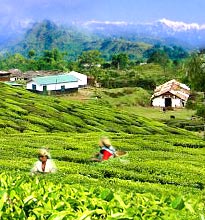 Masks, also known as mukhas, are said to be the base of the Assamese culture and tradition. They are worn mostly during theatres and bhaonas, which revolve around the Assamese tribal myths and folktales. Since ages, these masks have been the centre of each and every cultural event in the state. The traditional Assamese masks are made from a variety of materials, ranging from terracotta and bamboo to wood, pith and metals. They usually represent the local gods and goddesses, characters of ancient epics like the Mahabharata or historical figures.
Masks, also known as mukhas, are said to be the base of the Assamese culture and tradition. They are worn mostly during theatres and bhaonas, which revolve around the Assamese tribal myths and folktales. Since ages, these masks have been the centre of each and every cultural event in the state. The traditional Assamese masks are made from a variety of materials, ranging from terracotta and bamboo to wood, pith and metals. They usually represent the local gods and goddesses, characters of ancient epics like the Mahabharata or historical figures.The size of Assamese masks may vary from those that cover the whole body and measure one hundred and seventeen inches by sixty four inches to the ones that only cover the face. Depending on the size, these masks are divided into three types - Cho mask, Lotokoi mask Mukh mask. Cho mask is the biggest in size and usually made of two parts - head and body. Lotokoi mask is a smaller version of the Cho mask and the Mukh mask only covers the face. In Assam, the masks of Majuli are very popular. They are made of clay, bamboo, or cloth and are light in weight, which makes them unique.
The mask- making industry is a major means of livelihood for the rural population of Assam. These craftsmen do not belong to any specific caste group, rather are distributed throughout the state. The skill of making the masks is generally passed down either from one generation to the next or in a satra, under the guidance of a teacher. In Assam, mask making an extensive process, which involves splitting of bamboo strips to form the frame, pasting layers of clothes dipped in clay and finally drying them under the sun. The normal time required for completing a mask is around 10 to 15 days.
Usually earth or vegetable colors are used to give the final touch to the traditional Assamese masks, with the most common colors being those of red and yellow. However, nowadays, chemical dyes are also being used to give a better effect. Recent times have seen a growth in the production of these masks, as many modern day homes use them as decorative items in their drawing rooms. This has greatly increased the self- employment opportunities of the traditional mask-makers, thus improving their standard of living.











